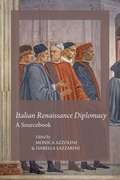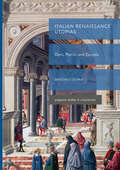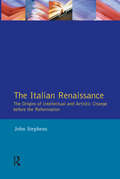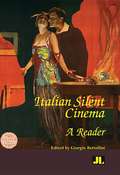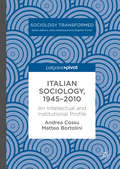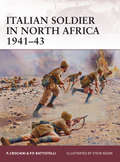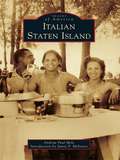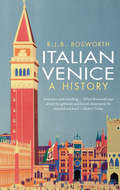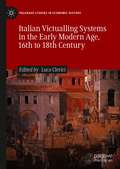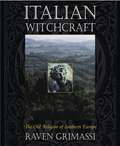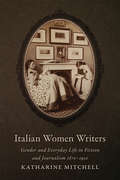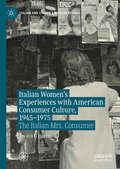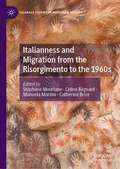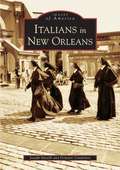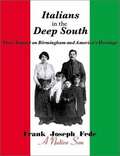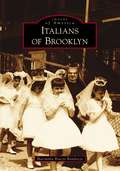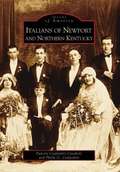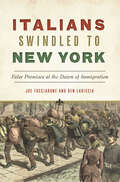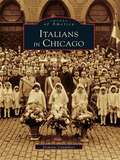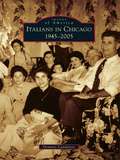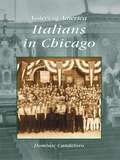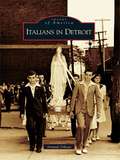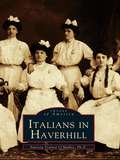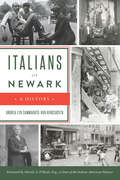- Table View
- List View
Italian Renaissance Diplomacy: A Sourcebook
by Isabella Lazzarini Monica Azzolini"Diplomacy has never been a politically neutral research field. The most recent research is moving away from diplomacy as an institutional tool and is increasingly viewing it as a social and cultural practice that enabled Europeans and non-Europeans alike to engage with each other in formal and informal, state and non-state contexts, through the elaboration of common languages, shared practices of communication, and political cultures. Since the nineteenth century, Renaissance Italy has been on the front line of diplomatic research. Italian polities have provided excellent case studies for the theory associating the beginnings of permanent diplomacy and the emergence of resident ambassadors with the process of state-building. Diplomacy during the period from about 1350 to about 1520 increasingly experimented with new ways of answering urgent political needs--to represent, negotiate, participate, and keep informed--by developing a broad range of innovative solutions that had to be integrated and absorbed within the traditional jurisdictional framework of medieval diplomacy. During the fifteenth century, diplomatic sources multiplied at an unprecedented rate, mostly due to the remarkable volume of dispatches exchanged between governments and envoys sent abroad for increasingly prolonged missions. The present book draws on these rich diplomatic sources, which are mostly unavailable to English readers. Most of the chapters present a selection of dispatches, either in their final version or in draft form; occasionally, instructions, letters of appointment, and final reports are added. The published and unpublished sources presented in English translation by the contributors to this volume cover a broad chronological and geographic arc. The aim is to illustrate the richness of diplomatic documents both for the study of diplomacy itself as well as for other less obvious areas such as gender and sexuality, crime and justice, art and leisure, and medicine. The potential for further study is practically infinite. The modest aim of this volume is to enrich classroom discussion and to bring diplomatic documents into focus for scholars and students interested in the Italian Renaissance more generally."--
Italian Renaissance Utopias: Doni, Patrizi, and Zuccolo (Palgrave Studies in Utopianism)
by Antonio DonatoThis book provides the first English study (comprehensive of introductory essays, translations, and notes) of five prominent Italian Renaissance utopias: Doni’s Wise and Crazy World, Patrizi’s The Happy City, and Zuccolo’s The Republic of Utopia, The Republic of Evandria, and The Happy City. The scholarship on Italian Renaissance utopias is still relatively underdeveloped; there is no English translation of these texts (apart from Campanella’s City of Sun), and our understanding of the distinctive features of this utopian tradition is rather limited. This book therefore fills an important gap in the existing critical literature, providing easier access to these utopian texts, and showing how the study of the utopias of Doni, Patrizi, and Zuccolo can shed crucial light on the scholarly debate about the essential traits of Renaissance utopias.
Italian Renaissance, The: The Origins of Intellectual and Artistic Change Before the Reformation
by John StephensIn this fascinating study, John Stephens inteprets the significance of the immense cultural change which took place in Italy from the time of Petrarch to the Reformation, and considers its wider contribution to Europe beyond the Alps. His important analysis (which is designed for students and serious general readers of history as well as the specialist) is not a straight narrative history; rather, it is an examination of the humanists, artists and patrons who were the instruments of this change; the contemporary factors that favoured it; and the elements of ancient thought they revived.
Italian Silent Cinema: A Reader
by Giorgio BertelliniItalian Silent Cinema: A Reader explores the largely forgotten world of Italian silent cinema, including its historical epics, comedies, serials, and romance melodramas. Thirty essays by leading scholars examine topics such as pre-cinema, international distribution, stardom, acting styles, literary adaptation, futurism, nonfiction filmmaking, and local exhibition. This groundbreaking and richly illustrated volume introduces scholars and students alike to a wealth of films, archival documents, and critical research.
Italian Sociology,1945–2010
by Andrea Cossu Matteo BortoliniThis book provides a comprehensive profile of the development of sociology in Italy from the post-war period to the present day. The first English-language account of the history of Italian sociology, it focuses on the process of institutionalization of the discipline within the Italian university system and its changing relationships with extra-academic actors and institutions: political parties, unions, the Catholic Church, political and social movements, as well as local and national governments. Arranged chronologically across eight chapters, it presents all major steps in the development of the discipline in a theoretically-informed but accessible way. The authors explore the pioneering phase of the 1950s to the establishment of the first academic chairs in the 1960s, from the student revolts of 1968 to the creation of the first sociological association in the 1980s and up to the present day. It will appeal to social science and history scholars and students, as well as readers interested in the history of Contemporary Italy.
Italian Soldier in North Africa 1941-43
by Steve Noon Piero CrocianiFocusing on the Italian Army in North Africa during World War II, which fought alongside the Afrikakorps under Rommel versus Montgomery and Patton, this title combines with the previous Warrior series books on the subject (and other Osprey titles) to complete the picture of the War in the Desert. Despite the attention paid to the Afrikakorps over the years, it was the numerically far superior forces of the Italian Army that held the line and formed the bulk of the fighting power available to the Axis powers during the War in the Desert from 1941 through to 1943. Their performance has been unfairly criticized over the years - the best units of the Italian Army were equal to those of the British and Germans - but they suffered from a lack of mobility and poor equipment that made it impossible for them to meet mobile British forces on anywhere near equal terms. Despite this, the Italian Army went through many changes through the period, with the introduction of a variety of elite units - armoured, mechanised and parachute divisions that did much to restore the fighting reputation of the Italian soldier in the Desert War. Their German allies belatedly acknowledged this with the redesignation of Panzerarmee Afrika as 1st Italian Army in February 1943. This title details recruitment, organisation and experience of the Italian forces in this theatre, casting new light on a force whose fighting power and capabilities have been unfairly ignored and maligned for too long.
Italian Sonata (Noire #2)
by Emmanuelle De MaupassantWhat dark secrets lie within those walls? Madness, abduction, imprisonment... murder? The past does not lie quietly. Towering above its island of wave-lashed rock is Castello di Scogliera. Look up at the narrow windows, and you might think yourself watched. Something, or someone, has been waiting for Lady McCaulay to arrive… Arriving in Italy, Lady Cecile McCaulay is enchanted by the Castello di Scogliera and its glamorous inhabitants: the Conte di Cavour and, Lucrezia, his beautiful half-sister. However, their lavish welcome hides darker motives and a third resident walks the ancient corridors of the castle, by night, unseen. Meanwhile, Lord McCaulay and his new bride honeymoon on the Italian coast, unaware that malevolent forces threaten to destroy their new-found happiness. A sumptuous Gothic Romance, filled with mystery, intrigue, and the lure of the sensuous, from the pen of Emmanuelle de Maupassant. Italian Sonata is the second volume in the Noire trilogy.
Italian Staten Island (Images of America)
by Andrew Paul Mele James P. MolinaroThe great wave of European immigration in the late 19th and early 20th centuries brought more than four million Italians to America. It was one of the greatest mass emigrations in world history, and many settled in Staten Island. Following the opening of the Verrazano-Narrows Bridge in 1964, the island experienced another great influx of Italian immigrants, this time from the other boroughs of New York City. This new wave was responsible for doubling the island population by the year 2000. Italian Americans are evident in every avocation and in each corner of Staten Island society, with achievers in education, business, government, medicine, and sports and entertainment. Italian Staten Island chronicles the traditions, culture, and heritage of Italian Americans through more than 200 photographs.
Italian Venice
by R. J. BosworthIn this elegant book Richard Bosworth explores Venice--not the glorious Venice of the Venetian Republic, but from the fall of the Republic in 1797 and the Risorgimento up through the present day. Bosworth looks at the glamour and squalor of the belle époque and the dark underbelly of modernization, the two world wars, and the far-reaching oppressions of the fascist regime, through to the "Disneylandification" of Venice and the tourist boom, the worldwide attention of the biennale and film festival, and current threats of subsidence and flooding posed by global warming. He draws out major themes--the increasingly anachronistic but deeply embedded Catholic Church, the two faces of modernization, consumerism versus culture. Bosworth interrogates not just Venice's history but its meanings, and how the city's past has been co-opted to suit present and sometimes ulterior aims. Venice, he shows, is a city where its histories as well as its waters ripple on the surface.
Italian Victualling Systems in the Early Modern Age, 16th to 18th Century (Palgrave Studies in Economic History)
by Luca ClericiThis book illustrates the complexity and variety of victualling systems in early modern Italy. For a long time, the historiography of urban provisioning systems in late medieval and early modern times featured a conceptual opposition between victualling administration and the market. In this book, on the contrary, the term ‘victualling system’ (sistema annonario) is employed according to its historical meaning, designating an organised set of public and private channels, evolved typically in urban contexts, for the procurement and distribution of the goods essential for the daily life of common people. According to this definition, specifically, a victualling system included also the market, as one of the different channels for the procurement and distribution of goods. What characterises the Italian case in the European context are both the earliness of these institutions and the long-lasting political and economic fragmentation of the peninsula: these factors determined the great variety and complexity of the solutions adopted. In order to show these features, the analysis focuses on four central issues: the configuration of systems, institutional pragmatism and variety, articulation of circuits, and plurality of actors. The seven relevant case-studies included in this book, all based on direct archival research, cover a wide range of geographical contexts and institutional arrangements, from the North to the South of the peninsula, and include both large-sized cities (Milan and Rome), medium-sized cities (Bergamo, Vicenza, and Ferrara), and entire regions (the March of Ancona, and Sicily). This allows the reader to appreciate regional and local differences in detail, making this book of interest for academics and scholars in economic, social, and urban history.
Italian Witchcraft: The Old Religion Of Southern Europe
by Raven Grimassi Kimberly Nightingale Connie HillItalian Witchcraft (previously titled Ways of the Strega) by respected author Raven Grimassi is more than just a book about Witchcraft. It is a complete Book of Shadows. In it you will find the history of this ancient tradition, its legends and myths, as well as the rituals and rites that you can do today. You can be a Strega! <P><P> The book includes a full set of rituals that you can do. You'll find rituals for all of the Italian Witchcraft holidays including Shadow Fest, Lupercus, Tana's Day and more. You'll also find rituals for the Full Moon, births, funerals. <P><P> There is a practical side to this book, too. It is filled with instructions so that you can cast spells and work with the powers of incense, oils, herbs, and candles. You'll learn to work with the magick of the Moon and Stars. You'll be able to do protection rituals and learn how to cure someone who has received the "Malocchio" (Evil Eye). <P><P> Many of the mysteries revealed here have never been published before. You'll learn secret gestures of power and secret symbols. And you can use them all! Also revealed are the secrets of the tools of the Italian Witch. You'll learn how to prepare the "Spirit Blade" and the ritual wand. You'll learn how to make the Spirit Bowl and use to consecrate other tools and talismans. <P><P> If you're looking to discover real Witchcraft, or if you're already a Witch but are thinking about other traditions, this is the book for you.
Italian Women Writers: Gender and Everyday Life in Fiction and Journalism, 1870-1910 (Toronto Italian Studies)
by Katharine MitchellPost-Unification Italy saw an unprecedented rise of the middle classes, an expansion in the production of print culture, and increased access to education and professions for women, particularly in urban areas. Although there was still widespread illiteracy, especially among women in both rural and urban areas, there emerged a generation of women writers whose domestic fiction and journalism addressed a growing female readership. This study looks at the work of three of the most significant women writers of the period: La Marchesa Colombi, Neera, and Matilde Serao. These writers, whose works had been largely forgotten for much of the last century, only to be rediscovered by the Italian feminist movement of the 1970s, were widely read and received considerable critical acclaim in their day. In their realist fiction and journalism, these professional women writers documented and brought to light the ways in which women participated in everyday life in the newly independent Italy, and how their experiences differed profoundly from those of men.Katharine Mitchell shows how these three authors, while hardly radical emancipationists, offered late-nineteenth-century readers an implicit feminist intervention and a legitimate means of approaching and engaging with the burning social and political issues of the day regarding "the woman question" - women's access to education and the professions, legal rights, and suffrage. Through close examinations of these authors and a selection of their works - and with reference to their broader artistic, socio-historical, and geo-political contexts - Mitchell not only draws attention to their authentic representations of contemporary social and historical realities, but also considers their important role as a cultural medium and catalyst for social change.
Italian Women's Experiences with American Consumer Culture, 1945–1975: The Italian Mrs. Consumer (Italian and Italian American Studies)
by Jessica L. HarrisThis book analyzes the spread of American female consumer culture to Italy and its influence on Italian women in the postwar and Cold War periods, eras marked by the political, economic, social, and cultural battle between the United States and Soviet Union. Focusing on various aspects of this culture—beauty and hygiene products, refrigerators, and department stores, as well as shopping and magazine models—the book examines the reasons for and the methods of American female consumer culture’s arrival in Italy, the democratic, consumer capitalist messages its products sought to “sell” to Italian women, and how Italian women themselves reacted to this new cultural presence in their everyday lives. Did Italian women become the American Mrs. Consumer? As such, the book illustrates how the modern, consuming American woman became a significant figure not only in Italy’s postwar recovery and transformation, but also in the international and domestic cultural and social contests for the hearts and minds of Italian women.
Italianness and Migration from the Risorgimento to the 1960s (Palgrave Studies in Migration History)
by Manuela Martini Stéphane Mourlane Céline Regnard Catherine BriceThis edited collection explores the notion of Italianness - or Italianità – through migration history. It focuses on the interaction between Italians circulating around the world, and their relationship with Italy from a political and cultural perspective. Answering the important question of how migration affects Italianness, the authors explore the ways in which migrants retained their Italian culture, customs and practices during and after their travels. Spanning a long period from the Risorgimento up until the 1960s, the book sheds light on the institutions and social structures that contributed to the construction of cultural links between Italian migrants and their country of origin. Not only broad in its temporal scope, the volume covers a wide geographic area, examining the lives of Italian migrants in North America, South America, Europe, North Africa, and the Middle East. Bringing together a wealth of research on Italians, alongside the different migratory routes taken by these men and women, this book provides new insights into Italian culture and seeks to strengthen our understanding of Italian migration history.
Italians In New Orleans (Images Of America Series)
by Dominic Candeloro Joseph MaselliBetween 1850 and 1870, New Orleans boasted the largest Italian-born population of any city in the United States. Its early Italian immigrants included musicians, business leaders, and diplomats. Sadly, in 1891, 11 members of the large Sicilian settlement in New Orleans were victims of the largest mass lynching in American history. However, by 1910, the city's French Quarter was a "Little Palermo" with Italian entrepreneur, laborers, and restauranteurs dominating the scene.
Italians In The Deep South: Their Impact On Birmingham And The American Heritage
by Frank J. FedeFede (Fee-dee) was raised in Birmingham's Little Italy. He tells us how labor shortages drew Italian immigrants to Birmingham's coal and steel industries. These new Americans quickly became farmers, grocers, and merchants, and the next generation became doctors, bankers, and lawyers. Their collective history helped shape the culture of the growing city, which was enriched by their contributions to religion, sports, art, commerce, and politics.
Italians Of Brooklyn (Images Of America)
by Marianna Biazzo RandazzoBrooklyn, or "Bruculinu," as many Italians affectionately pronounced it, is where Italian values, culture, and dreams thrived. In an era when over four million Italians found their way to America, the first significant influx came during the 1880s, primarily from rural peasant communities fleeing poverty and overpopulation. Although Italians in South Brooklyn have been traced back as far as the 1820s, most settled in Manhattan. The 1855 New York Census did not list any Italian natives in Brooklyn; however, by 1890, there were 9,563 Italians residing in the borough. By 1900, Brooklyn's Italian population was second only to Manhattan. Although the last notable wave of Italian immigration ended in the 1960s, Italian remains one of the six prevalent foreign languages in New York according to a 2007 census estimate. This work serves as a time capsule to remind us of the contributions and influences these immigrants have offered to the community.
Italians Of Newport And Northern Kentucky (Images Of America)
by Pamela Ciafardini Casebolt Philip G. CiafardiniThis volume tells the story of the wonderful Italian people who immigrated to Northern Kentucky, settling in Newport, Covington, Clifton (Spaghetti Knob), and Cote Brilliante. Their history is preserved in images of families, weddings, military heroes, businesses, and holy ceremonies. They worshipped at St. Vincent de Paul Parish, found jobs at Newport Rolling Mill and tailor shops, opened their own businesses, and served in World War I and World War II. All along, they kept memories of Italy alive in their kitchens and gardens. Readers will gain an appreciation for the positive influences these Italian Americans had on Northern Kentucky.
Italians Swindled to New york: False Promises at the Dawn of Immigration (American Heritage)
by Joe Tucciarone Ben LaricciaThe unification of Italy in 1861 launched a new European nation promising to fulfill the dreams of Italians, yet millions of poor peasants still found themselves in economic desperation. By 1872, an army of speculators had invaded the countryside, hawking steamship tickets and promising fabulous riches in America. Thousands of immigrants fled to the New World, only to be abandoned upon arrival and forced to find work in hard labor. New York placed victims of deception at the State Emigrant Refuge on Ward's Island as the secretary of state and the Italian prime minister sought to intervene. Through steel-eyed determination, many surmounted their status and became leaders in business and culture. Authors Joe Tucciarone and Ben Lariccia follow the early stages of mass Italian immigration and the fraudulent circumstances that brought them to New York Harbor.
Italians in Chicago: 1945-2005 (Images of America)
by Dominic CandeloroThe stories of Chicago's Italian communities are an important part of the rich and diverse mosaic of Chicago history. As a rail center, an industrial center, and America's fastest growing major city, Chicago offered opportunities for immigrants from all nations. Italians in Chicago presents an intriguing narrative record of the earliest beginnings of Italian communities in the city, going back to the 1850s. It explores the lives of ten significant members of the Chicago Italian-American community.This book is a collaborative, cumulative effort, and gives glimpses and echoes of what occurred in the Italian-American past in Chicago. Including vintage images and tales of such individuals as Father Armando Pierini, Anthony Scariano, and Joe Bruno, and groups such as the Aragona Club and the Maria Santissima Lauretana Society, this collection uncovers the challenges and triumphs of these Italian immigrants.
Italians in Chicago: 1945-2005 (Images of America)
by Dominic CandeloroMore than 25,000 Italian immigrants came to Chicago after 1945. The story of their exodus and reestablishment in Chicago touches on war torn Italy, the renewal of family and paesani connections, the bureaucratic challenges of the restrictive quota system, the energy and spirit of the new immigrants, and the opportunities and frustrations in American society. Drawn from scores of family albums, these intimate snapshots tell the story of the unique and universal saga of immigration, a core theme in American and Italian history.
Italians in Chicago: 1945-2005 (Voices of America)
by Dominic CandeloroThe stories of Chicago's Italian communities are an important part of the rich and diverse mosaic of Chicago history. As a rail center, an industrial center, and America's fastest growing major city, Chicago offered opportunities for immigrants from all nations. Italians in Chicago presents an intriguing narrative record of the earliest beginnings of Italian communities in the city, going back to the 1850s. It explores the lives of ten significant members of the Chicago Italian-American community.This book is a collaborative, cumulative effort, and gives glimpses and echoes of what occurred in the Italian-American past in Chicago. Including vintage images and tales of such individuals as Father Armando Pierini, Anthony Scariano, and Joe Bruno, and groups such as the Aragona Club and the Maria Santissima Lauretana Society, this collection uncovers the challenges and triumphs of these Italian immigrants.
Italians in Detroit (Images of America)
by Armando DelicatoPeople of Italian descent have been present in Detroit since Alfonso Tonti, second-in-command to Antoine Cadillac, participated in the founding of the city in 1701. By the close of the 19th century, the trickle of Italian immigrants had become a torrent, as thousands rushed to the growing industrial center. Settling on the lower east side, the community grew rapidly, especially north and east into Macomb County. Italians in Detroit did not remain in a "little Italy," but mingled with the diverse population of the city. Through a combination of hard work and strong family and community ties, the Italians of Detroit have achieved their dreams of a better life. They have met the challenges of living in a new land while nurturing the culture of the old country. The challenge that remains is to nurture a love ofheritage among young Italian Americans as the immigrant generation fades.
Italians in Haverhill
by Patricia Trainor O’malleyItalian immigrants became permanent residents of Haverhill in the 1870s. The original Genoese first drew their relatives and friends from their home area to join them. Over the next few decades, they were joined by families from the central province of Abruzzi and from the towns and villages around Naples. Immigrants from parts of southern Italy, such as Calabria and Apulia and Sicily, settled here. All of the Italians, whether northern or southern, brought with them their culture, their vitality, their love of music, and their close family ties. Using over two hundred thirty vintage photographs, Italians in Haverhill takes a photographic walk through the exciting history of these immigrants. The images bring back to life representatives of more than two hundred families, whose descendants still live in the area. Here are the fruit sellers and shoe workers, the mothers and their children, the ball players and the musicians, the lawyers and doctors, and the bankers and civic leaders who make up the rich heritage of this important ethnic group.
Italians of Newark: A History (American Heritage)
by Van Benschoten AndreaFaith, family and food. Between 1880 and 1924, more than four million Italians immigrated to the United States. Tens of thousands flocked to Newark and reshaped a city. Many settled in the Old First Ward, which once claimed the title of largest Little Italy in New Jersey. Clubs like the Spilingese Social Club sprang up to provide support and camaraderie and dishes like giambotta made their way into everyone's kitchens. Author Andrea Lyn Cammarato-Van Benschoten traces the roots of Newark's Italian communities.
